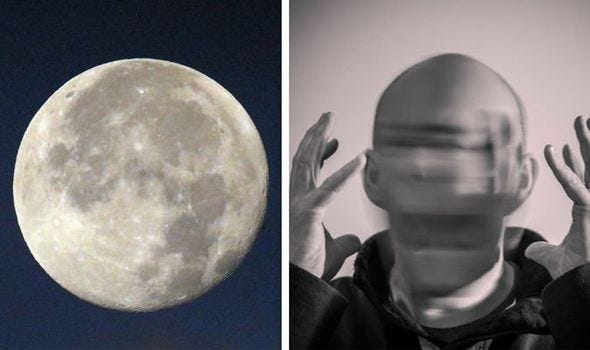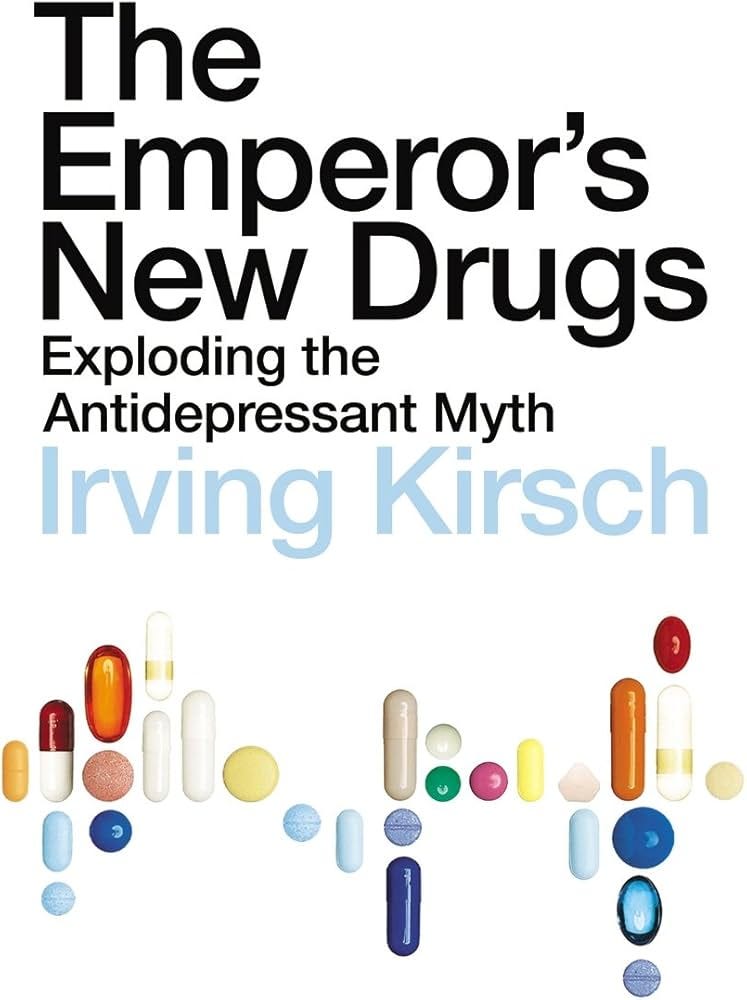You Are on an SSRI
Yes, you. All of you. No, it's not what you think, it's not the food or water or air. It's worse than that because it's completely hidden from awareness and yet it's everywhere.
The term "lunatic" comes from "luna," the Latin word for moon.
Historically, it was believed that the full moon could cause temporary madness or just erratic behavior in people, particularly women (yes, history is sexist). This idea extended to folklore, where the full moon was thought to have supernatural influences on humans, leading to transformations into werewolves (or other “were” animals depending on continent and local species availability, so werelion, weretiger, werehyena, etc).
Pliny the Elder was a Roman philosopher who suggested that the Full Moon caused more dew to form, which he believed led to increased moisture in the brain and subsequent madness.
A British judge in the 1700s noted that a "lunatic" was someone whose mental state fluctuated with the phases of the moon.
Ancient medical systems widely acknowledge the moon's influence on human health and behavior. Ancient Chinese Medicine associates the moon with feminine Yin energy, affecting the balance of Yin and Yang, and times treatments to the lunar cycle. Ayurveda links the moon's phases to the body's doshas (Vata, Pitta, Kapha), the full moon is thought to increase Kapha, while the new moon is said to increase Vata, so Ayurveda recommended specific diets and fasting on certain lunar days. Greek Unani medicine emphasizes the moon's impact on bodily fluids and advises timing treatments with lunar phases. In Western traditions, both Hippocratic and medieval medicine believed the moon affected disease progression and recovery, often consulting lunar charts for optimal treatment timing.
However modern studies investigating a correlation between lunar phases and psychiatric admissions haven’t shown any significant link.
Research by scientists at the University of Washington, Yale University, and the National University of Quilmes in Argentina did find that sleep patterns oscillate with the 29.5-day lunar cycle. They observed that people tend to go to bed later and sleep less on nights preceding a full moon, an effect more pronounced in rural indigenous communities with limited or no access to artificial light, though also noted in industrial societies, so there is some biological link to moon cycles nowadays that may have something to do with light, it’s just not that pronounced.
If the effects so widely noted throughout the ancient world were in whole or in part mediated by changes in the brightness of the moonlight during different phases of the lunar cycle, then the previously noted link on behavior may have been overcome by the modern prevalence of artificial light at night (ALAN).

Support for this comes from indigenous cultures without artificial light, where the menstrual cycle is often observed to synchronize with the lunar cycle. Traditionally, it was noted that women menstruate during the new moon and ovulate during the full moon.
Menstruation in traditional cultures was associated with introspection, renewal, and rest. This phase was often linked to lower energy levels and the desire or need for seclusion and reflection.
The full moon on the other hand was associated with ovulation, characterized by higher energy levels, increased fertility, and a peak in creativity.
Research shows a link between blue light and Follicle Stimulating Hormone (FSH) production during the follicular phase directly preceding ovulation.
During ovulation, Luteinizing Hormone, Estrogen and FSH all rise.
Blue light can increase the levels of all of these hormones, so exposure to brighter blue light during the full moon could certainly predispose women to ovulation at that time.
But far more persuasive than that little sexist aside into women’s monthly mood swings, is historical and contemporary research that indicates that the prevalence of artificial lighting has had significant impacts on mental health, potentially supporting the concept of moon madness. Studies have found that excessive exposure to artificial light at night can disrupt circadian hormonal rhythms, leading to increased risks of psychiatric disorders such as anxiety, depression, bipolar disorder, and PTSD.
A study published in Nature Mental Health involving over 85,000 participants revealed that those exposed to high levels of nighttime light experienced a 30% increase in depression risk.
This effect was found to be consistent across various demographics (finally! not sexist at all!) and living environments, reinforcing the idea that artificial light exposure at night is a significant risk factor for mental health disorders.
It helps to put this all into perspective and understand why it actually happens.
You’re on an SSRI and it’s too much light at night
In the morning you’re meant to naturally be exposed to sunlight, which should stimulate the production of various daytime hormones including serotonin, dopamine, adrenaline, cortisol, insulin, testosterone, estrogen, etc.
Now, serotonin is the precursor to melatonin, a nighttime hormone. But actual production of melatonin from serotonin is only stimulated by darkness.
If we leave the lights on after sunset we’ll produce less melatonin that night, which means we won’t metabolize some of the serotonin floating around into melatonin. Which means we’ll have more serotonin than we need left over.
And what if we take some melatonin to help get to sleep since the light prevented us from making enough?
The same thing will happen, but it will be worse. Because in that case we’ll need to convert even less serotonin into melatonin.
And even if the excess serotonin were metabolized away, light itself directly stimulates serotonin production (along with all the other hormones I mentioned earlier).
What happens if serotonin levels rise higher than they should?
It’s like being on an SSRI, which stands for selective serotonin reuptake inhibitor. What an SSRI does is prevent serotonin from being recycled by neurons after it’s released, so it leaves more serotonin inside of synapses in the brain. Basically there’s more serotonin left hanging around, just like we see with extended blue light exposure at night, when we do not recycle or convert enough serotonin into melatonin (and at the same time we stimulate even more production, so it’s actually even worse than an SSRI).
What does high serotonin do?
Chronically elevated serotonin will lead to increased cortisol production, prolactin excess, and disrupted levels of thyroid hormone, growth hormone, sex hormones, oxytocin, and insulin (what it doesn’t do is help prevent or treat any psychiatric disease despite the decades of marketing to the contrary - see many excellent exposes like The Emperor’s New Drugs).
Let’s trace out the further implications of just the first of those effects of higher serotonin: chronically elevated cortisol will lead to weight gain, insulin resistance, hypertension, heart disease, low immune function, muscle weakness, osteoporosis, mood disorders, cognitive impairment, reproductive hormone imbalances, skin and hair problems, and digestive upset. It does this by affecting the levels of insulin, thyroid hormones, sex hormones, growth hormone, prolactin, adrenaline, leptin and ghrelin.
And we could keep going down each of these pathways documenting how each disruption spreads outward in every worsening butterfly effects, all due to a simple seemingly harmless decision to turn the lights on after dark.
Now imagine what happens to all your other hormones and neurotransmitters that are also supposed to be influenced by circadian cycles like dopamine, insulin, cortisol, growth hormone, testosterone, estrogen, prolactin, aldosterone, leptin, ghrelin and glucagon.
These are the dials of your immunity, metabolism, motivation, focus, sex drive, blood pressure, recovery, blood sugar, appetite regulation, and more.
Dopamine excess is associated with psychiatric diseases like schizophrenia and bipolar disorder, as well as being linked to addictions like gambling, alcohol and drugs (and social media).
The hormones that are supposed to be high during the daytime hours will be over expressed by a longer “day” when you leave the lights on after sunset. Then organs that make them will be chronically overtaxed.
Now imagine doing that for years, decades, your whole life.
No wonder people burn out.
Then the opposite situation may eventually occur: deficiencies of serotonin, dopamine, cortisol, adrenaline, etc.
Low mood, depression, chronic fatigue, etc.
We aren’t designed for artificial lights at night. They make us fat, exhausted, sick and crazy in a thousand ways.
Turn off the lights and let the lunacy subside.








Or you can be weird like me and sleep right when the sun starts setting. I started this years ago when I didn't want to use an alarm clock anymore- which is another problem because you can't predict what REM cycle you will be in while the thing blasts off. If you're in a deep cycle in can wreck your day. Now my sleep cycle evolved to this being awake entirely with the sunlight (summer through winter) and I wake up naturally anywhere between 1:00 and 4:30 am, depending on what my body needs I guess. Another benefit is getting things done when everyone else is asleep. Of course I somewhat miss my previous nightly social events, but not really the alcohol, crappy TV shows, or occasional drama.
Years ago I remember dreading the full moon every month for 12 years. All special occasions and all normal days were planned around the full moon. Without exception my ex-husband became much more violent during this period. I never believed the powerful influence of the moon until I observed it personally. So not just women, but men are influenced as well.